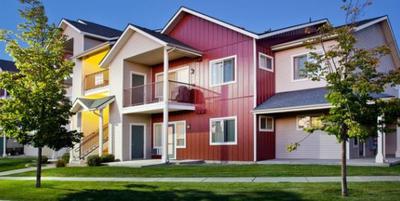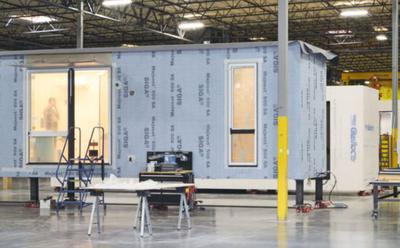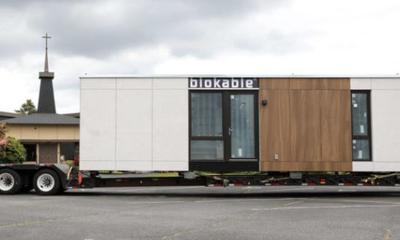Modular construction: a housing affordability game-changer?
by Erica Barnett
(www.sightline.org)

Mass production could make apartments radically cheaper and faster to build.
Is the future of apartment construction indoors?
The costs of physical construction—the “hard costs”—are the single biggest determinant of the selling price or rent of a new home.
That’s the bet a number of modular construction companies in the Pacific Northwest are making. Building in Cascadia is expensive. Labor is scarce, and rents have surged since the last recession. Firms like Blokable, Katerra, and OneBuild say that by moving much of the process off building sites and onto factory floors, they can cut the cost of constructing multifamily housing by over half. They also say they can finish projects in half the time. If these claims prove true, these companies and other like them could shake up the housing industry in cities like Seattle, where the total cost to produce a single apartment home can surpass $300,000.
The costs of physical construction—the “hard costs”—are the single biggest determinant of the selling price or rent of a new home. If modular construction slashes hard costs, homebuilders will make more homes—precisely what’s needed to control rising rents in cities facing housing shortages. Cutting hard costs also makes it possible to stretch public funds further, yielding more subsidized homes for low-income families as well.
So modular construction could be a housing affordability game-changer.
Tailor-made homes, tailor prices
Modular construction is hardly new. Mobile homes, a type of modular housing, have been a popular form of inexpensive housing for decades, and single-family modulars have become a relatively cheap option for first-time homeowners and empty nesters who don’t need lots of space. What is new is the idea that modular construction methods can be used to revolutionize the entire construction industry. This could be especially true for apartments and condos—the productivity of which has barely increased since 1945, according to the McKinsey Global Institute—and bring down the cost of housing in the process.
To understand why multifamily housing construction is so expensive, it helps to know how it’s usually built. The orchestrator of the whole process is the developer—the business person who puts the deals together, securing funds from a bank or investors (or government or charitable agencies, for subsidized housing), and hiring professionals to design and construct the building. Typically, the developer selects a general contractor, and that contractor, in turn, hires subcontractors, who then often hire sub-subcontractors, and so on. Eventually, the contractor at the bottom of this chain actually does the work. Every layer of subs takes on some of the huge risk of a giant construction project but also drives up costs.
Meanwhile, construction labor is at a premium nationally in the United States, and even more so in Cascadia’s booming major cities. According to a recent analysis of affordable and market-rate multifamily construction costs in Portland, “a severe shortage of both skilled and unskilled labor in the PDX construction market” has led to cost escalation greater than the rest of the country.
Modular housing minimizes the layers of contractors, putting most or all of the construction processes under the control of one company.
This shortage boosts construction wages and the cost of housing. On top of that, many construction workers cannot afford to live in the expensive cities that most need more housing, creating a vicious circle of rising rents exacerbated by a lack of a local workforce to build homes, and so on.
Modular housing minimizes the layers of contractors, putting most or all of the construction processes under the control of one company. It also standardizes everything it can, making home construction more like a modern, automated clothing factory and less like a tailor shop, where each garment is made by hand to custom specifications.
Some modular companies, like Katerra, build prefabricated components that can be put together quickly at a building site; others, like Blokable, manufacture entire apartments that just need to be stacked into place like Legos. But all have essentially the same mission statement: By eliminating some of the players and processes that make traditional housing expensive, modular boosters say, they can build more housing, faster, for less.
In any growing city’s housing market dance, homebuilders pause when the stockpile of new homes pushes down rents to a level where it’s no longer profitable to build. But when costs can be cut—through cheaper construction methods like modular building or other cost-reducing measures—the no-build tipping point occurs at a lower rent. The result is more new homes get built, and rents drop that much further before homebuilding slows down. If modular construction can deliver anything like the savings its proponents project, it could take a giant bite out of rents and prices.
The same goes for the production of subsidized affordable housing, increasingly threatened across the US by the ongoing loss of federal and state funding. A big reduction in construction costs could enable non-profit developers to move projects forward with less public subsidy.
Located in Tacoma, Katerra’s 207 Meridian development consists of 24 units across eight different three-story buildings, rendering used with permission. Image by Katerra
Katerra: The Ikeaization of homebuilding
One company that hopes to take all the guesswork out of modular construction—by controlling every aspect of the process—is Katerra, a Menlo Park, CA-based startup. It was founded on the idea that vertical integration is the best way to cut costs and eliminate surprises during design and construction. Katerra, which declined requests for an interview, is building a 250,000-square foot factory in Spokane Valley, where it will manufacture panels made of cross-laminated timber (CLT) and another mass-timber product called Glulam. Mass-timber products are composite materials made from scraps of wood and glue, and are strong enough to substitute for steel in high-rise buildings, allowing taller wood-framed buildings than can be built with ordinary lumber.
Rendering of Katerra’s 150-unit five-story Revel Kirkland Senior Living facility that is currently under construction, used with permission. Image by Katerra
Once the factory is up and running, Katerra will be able to build CLT panels to order and snap them together on site, like flat-pack Ikea furniture panels that can be fitted together in a number of different configurations, allowing what the company calls “mass customization” using a predetermined, but customizable, kit of parts. Developers can specify everything from the size and configuration of the units to the finishes, and Katerra will build semi-custom components to order.
Katerra was founded just three years ago—by Michael Marks, the former CEO of electronics manufacturer Flextronics and interim CEO of Tesla; Jim Davidson, the founder of a private-equity firm; and Fritz Wolff, founder of national multifamily housing developer The Wolff Company. Now, it already has more than 1,300 employees in five states and four countries, and it recently raised $865 million from investors including SoftBank, a Japanese conglomerate. Katerra has also acquired a number of high-profile architecture and design firms, including Nystrom Olson in Spokane and Michael Green Architecture in Vancouver, BC.
Katerra has $1.3 billion in outstanding orders for new construction projects, including a handful of apartment buildings at various stages of design and construction in Oregon and Washington. (None have been completed so far.) Most of Katerra’s planned projects in Cascadia are located in suburban areas such as Kirkland (just east of Seattle) and Spokane Valley (to the east of Spokane, and close to Katerra’s planned CLT factory). Katerra plans to provide a range of services on each project. This includes architecture and engineering using Katerra’s standardized components (a 360-unit affordable housing complex in Snohomish County) to a full-service package that includes standardized CLT components (a 400-unit, under-construction market-rate project in Kirkland).
Blokable: A Lego approach to homebuilding
Aaron Holm, a former Amazon product manager and founder of the Vancouver, Washington-based modular builder Blokable, says the problem his company is trying to solve “is not to make more margin for general contractors or developers. It’s to make a dent in the housing problem.” In fact, Blokable is focusing on subsidized affordable housing, which the company says it can build at prices that are substantially lower than the $300,000 per unit that is often cited as the average cost of building affordable housing in Seattle.
Nelson Del Rio, Holm’s co-CEO, likens the layers of contractors on a conventional building project to hogs at a trough. “Every time we extract something out of that trough for the hogs, … the end users, the working class, the people who can’t afford to live in town—they end up paying for it.”
Join in and write your own page! It's easy to do. How? Simply click here to return to News portal.







